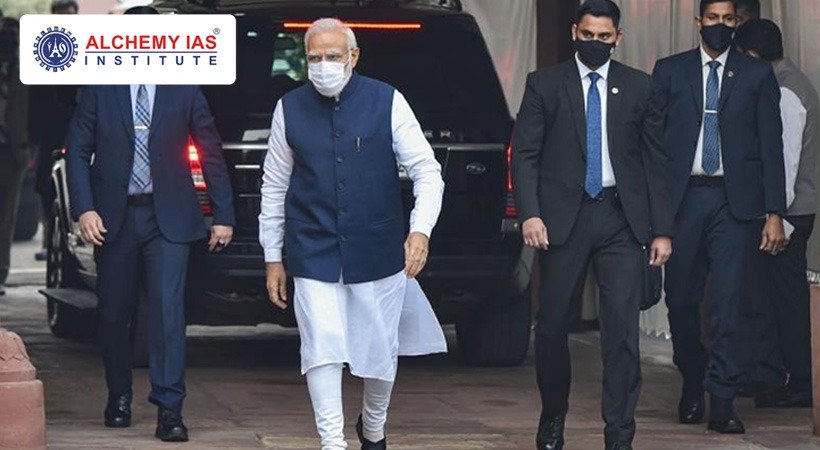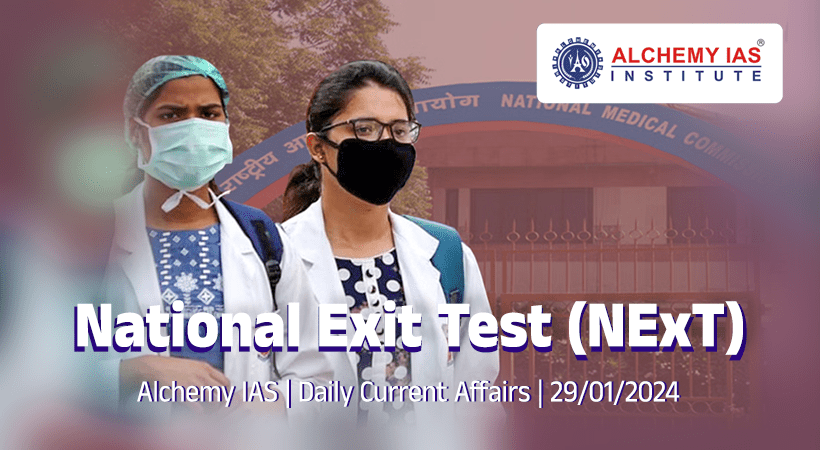NATIONAL MEDICAL COMMISSION & NATIONAL EXIT TEST
Syllabus: GS.2: Indian Polity & Governance: Important Bodies in News
Why in News: After being in the offing for nearly two years, the National Exit Test (NExT) has hit the pause button yet again this week with the National Medical Commission (NMC).
About the National Medical Commission (NMC)
- Establishment:
- The National Medical Commission (NMC) is a statutory body established under the National Medical Commission Act, 2019.
- The NMC is responsible for overseeing medical education, practice, and institutions.
- The NMC replaced the erstwhile Medical Council of India (MCI) which was established in 1934.
- Composition & Tenure
- The NMC comprises four boards: Undergraduate Medical Education Board (UGMEB), Postgraduate Medical Education Board (PGMEB), Medical Assessment and Rating Board, and Ethics and Medical Registration Board.
- It consists of 25 members, including the Chairperson, Presidents of PGMEB and UGMEB, and Directors General of Indian Council of Medical Research (ICMR) and Health Services.
- Tenure of NMC members is four years (except for part-time members whose tenure is two years).
- The NMC chairpersons and other members, nominated by the Central government, cannot be renominated.
- Any decision requires approval of the majority (minimum 13 out of 25) of the Commission.
- NMC has been awarded the World Federation for Medical Education (WFME) Recognition Status for 10 years, the highest standards in medical education and accreditation.
What is NExT (National Exit Test)?
- The NExT is a medical licensing exam that is designed to assess the competency of medical graduates.
- Students who received their medical degrees from NMC approved medical institutions and overseas students also will have to qualify the National Exit Test.
- To register for medical practice in India, they must pass the NExT test.
- The NExT will comprise two separate exams called ‘Steps’.
- The NExT will replace the final MBBS exams, the National Eligibility-cum-Entrance Test for postgraduate seats (NEET-PG), and the Foreign Medical Graduate Examination (FMGE) for foreign medical graduates to practice medicine in India.
- National Medical commission (Amendment) Bill, 2022, proposes an autonomous board, ‘Board of Examinations in Medical Sciences’, which, when comes to effect, will be responsible for holding the NExT exam.
PLACES OF WORSHIP (SPECIAL PROVISIONS) ACT, 1991
Syllabus: GS.1 & GS.2: Indian Society & Indian Polity: Act in News
Why in News: Efforts to transfer the Gyanvapi mosque to Hindus persist despite appeals to safeguard the Places of Worship (Special Provisions) Act of 1991, ensuring preservation of religious character since August 15, 1947.
About the Places of Worship Act, 1991?
- The 1991 Act provides a guarantee for the preservation of the religious character of places of public worship as they existed on August 15, 1947.
- It seeks to uphold the secular fabric of India and protect the rights and interests of all religious communities.
- It is described as “An Act to prohibit conversion of any place of worship and to provide for the maintenance of the religious character of any place of worship as it existed on the 15th day of August 1947, and for matters connected there with or incidental thereto.
- Section 4(1) of the Act declares that the religious character of a place of worship “shall continue to be the same as it existed” on 15th August 1947.
- Exemption
- The disputed site at Ayodhya was exempted from the Act. Due to this exemption, the trial in the Ayodhya case proceeded even after the enforcement of this law.
- The Act also exempts any place of worship classified as an ancient or historical monument under the Ancient Monuments and Archaeological Sites and Remains Act, 1958, suits already settled, and disputes resolved or conversions through acquiescence before its commencement.
- Criticism
- It has been questioned by some critics who argue that it ignores the historical injustices and encroachments suffered by some religious groups before August 15, 1947. They assert that the Act denies them the opportunity to reclaim and restore their places of worship.
- The law has been challenged on the ground that it bars judicial review, which is a basic feature of the Constitution, imposes an “arbitrary irrational retrospective cutoff date,” and abridges the right to religion of Hindus, Jains, Buddhists, and Sikhs.
- About the Gyanvapi Mosque dispute
- The Gyanvapi Mosque dispute revolves around its alleged construction over the demolished Vishweshwar temple by Aurangzeb in 1669.
- Descendants of the temple’s priests initiated the case in 1991, seeking its return.
- The Muslim side disputes the court’s jurisdiction under the Religious Places Act of 1991, which prohibits converting places of worship and limits litigation before August 15, 1947, except for the Ayodhya dispute. The petition was dismissed in 1998, but it resurfaced in 2019 after the Ayodhya verdict by the Supreme Court.
- Hindu groups sought prayer rights, leading to court battles.
- Varanasi lawyer Vijay Shankar Rastogi filed a petition alleging illegalities in mosque construction, prompting an archaeological survey.
- The discovery of a ‘Shivling’ during surveys intensified the dispute.
- The Allahabad High Court permitted a survey, but the Supreme Court temporarily halted it.
- Despite legal back-and-forth, the ASI conducted surveys, submitting reports to the Varanasi court.
- The controversy, entangled in legal and religious intricacies, underscores tensions over historical religious sites, with ongoing debates surrounding the mosque’s status and heritage preservation.
- Way Forward
- The Places of Worship Act, 1991, serves as a vital safeguard for religious harmony and secularism in India. While preserving the religious character of places of worship, it ensures equal respect for all faiths. However, it’s essential to address concerns raised by critics regarding historical injustices. Through transparent dialogue and inclusive policies, we can navigate disputes like the Gyanvapi Mosque case, fostering communal harmony and upholding democratic principles.
- Top of Form
SECURITY COVERAGE PROVIDED IN INDIA

Syllabus: GS 3: Security of India
Why in News: Centre grants Z-plus security to Kerala Governor after he says police being lax about his protection.
Security coverage provided in India
- In India, security cover is offered to recognised personalities whose lives are at jeopardy owing to their work or popularity.
- Different sorts of security are supplied depending on the information provided by the intelligence agency in order to safeguard them from such anti-social forces.
- The level of security needed by any individual is decided by the Ministry of Home Affairs, based on inputs received from intelligence agencies which include the IB and R&AW.
- The levels of security coverage provided in India, in ascending order, are X, Y, Y-plus, Z, Z-plus and the Special Protection Group (SPG).
Special Protection Group (SPG)
- The Special Protection Group (SPG) now provides security exclusively to the current Prime Minister and their immediate family members residing with them, following a recent amendment.
- Established in 1985 after Indira Gandhi’s assassination and formalized by an Act in 1988, the SPG comprises 3,000 personnel and highly trained dogs.
- The Central Government, under the Ministry of Home Affairs, oversees SPG operations, determining security levels based on threat assessments.
- In 2019, security for Sonia, Rahul, and Priyanka Gandhi was downgraded from SPG to Z-plus after earlier receiving protection post-Rajiv Gandhi’s assassination in 1991.
Z-plus
- Z-plus security, second only to SPG, offers high-level protection with 55 personnel and CRPF commandos providing 24×7 securities. NSG commandos may join based on intelligence.
- It includes a bulletproof vehicle and three-shift escort. Commandos undergo expert martial arts training.
- Recipients include Home Minister Amit Shah, UP CM Yogi Adityanath, and Union Finance Minister.
Z-category
- Z-category is the country’s third-highest level of security protection and includes 22 personnel, along with commandos and police personnel. Under the Z-category, a private individual pays for the security cover.
- Baba Ramdev and actor Aamir Khan have been given Z-category security protection.
Y-plus, Y category security
- Y category security cover includes eight to 11 personnel, including a couple of commandos. It also comprises two personal security officers (PSOs). Many VIPs in India have been given this level of security protection.
- For instance, actor Kangana Ranaut and Vivek Ranjan Agnihotri, director of The Kashmir Files, have been given Y-category protection.
X Level Security:
- This is India’s fifth critical security level, and its protection cover comprises two security professionals, both of whom are armed police officers.
- It is offered to several people around the country by a single Personal Security Officer.
- It is offered to several people around the country by a single Personal Security Officer.
Also Read
INS VISAKHAPATNAM & GULF OF ADEN
Syllabus: GS. 3: Defence Technologies in News & Places / seas in News
Why in News: Yemen’s Huthis claimed a missile strike on a British oil tanker in the Gulf of Aden that set the vessel on fire, the latest attack on international shipping by the Iran-backed rebels. Indian Navy team helps bring fire under control on oil tanker hit by Houthi missile in Gulf of Aden. The Iran-backed group has been targeting merchant vessels on the key global trade route, which they say is in response to the Israeli offensive against Hamas in Gaza.
About INS Visakhapatnam:
- It is the lead ship and the first of the Indian Navy’s Visakhapatnam-class stealth guided-missile destroyers.
- It was commissioned on November 21, 2021, is one of the largest destroyers in Indian Navy service.
- The ship symbolises India’s matured shipbuilding capability and quest for the Make in India initiative towards achieving ‘Atmanirbhar Bharat’.
- The crew of the ship abides by her motto ‘Yasho Labhasva’ – a Sanskrit phrase that translates to ‘Attain Glory’.
What are guided-missile destroyers?
- A guided-missile destroyer (DDG) is a large warship that is armed with a variety of missiles, guns, and other weapons.
- DDGs are designed to provide air defense, anti-submarine warfare, and anti-surface warfare for carrier strike groups, surface action groups, and expeditionary strike groups.
Gulf of Aden
- The Gulf of Aden is a significant water body located in the Arabian Sea between Yemen to the north and Somalia to the south.
- It connects the Arabian Sea to the Red Sea through the Bab-el-Mandeb strait.
- It is bordered by Yemen on the north, Somalia on the south, Djibouti and Eritrea on the west, and the Arabian Peninsula on the east.
ARABICA & ROBUSTA COFFEE
Syllabus: GS 3: Agriculture – Crops in News
Why in News: A study in Nature Communications, using chromosome-level assembly, uncovers Arabica coffee’s genetic diversity, potentially enhancing its flavor and pathogen resistance. Arabica accounts for 60% of global coffee production.
About Coffee Production in India
- More than 70% of the nation’s produce is exported. India is the eighth-largest volume exporter of coffee, according to The Food and Agriculture Organization (FAO).
- Coffee in India primarily grows in Karnataka, Kerala, and Tamil Nadu, forming the traditional region.
- Newer areas in Andhra Pradesh and Odisha, as well as the Northeast, also cultivate coffee.
- Indian coffee, mainly grown in the south under monsoon conditions, is referred to as “Indian monsooned coffee” and consists mainly of Arabica and Robusta varieties.
About Arabica & Robusta:
- Arabica coffee, known for its mild flavor and aromatic beans, holds higher market value than Robusta.
- Robusta, prized for its strength, is commonly used in blends.
- Arabica thrives at higher altitudes but is more vulnerable to pests and diseases like White Stem Borer and leaf rust, requiring greater shade compared to Robusta.
- Arabica harvests occur from November to January, while Robusta is harvested from December to February.
Coffee Board of India
- The Ministry of Commerce and Industry is in charge of the Coffee Board of India, which was founded in 1942.
- The Board’s actions are generally focused on improving production, productivity, and quality; promoting exports to increase the value returns for Indian coffee; and fostering the growth of the domestic market.
- The head office of the Coffee Board is situated in Bangalore.


